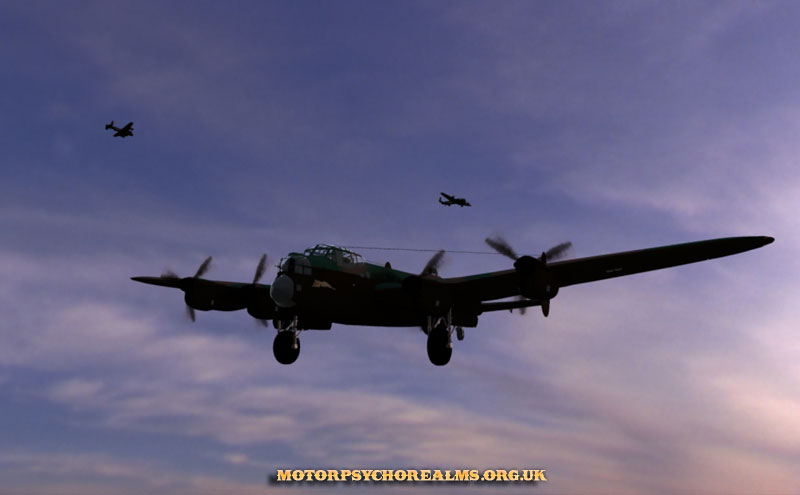Avro Lancaster MkI - Safe Return

Avro Lancaster MkI - Safe Return; digital Illustration by Les Still
Avro Lancaster
Origin;- A.V.Roe Ltd., also Armstrong Whitworth, Austin Motors, Metropolitan-Vickers and Vickers-Armstrongs UK and Victory Aircraft Canada.
Type;- Seven seat heavy bomber.
Engines;- Four 1,460hp Rolls-Royce or Packard Merlin 20 or 22, (MkII only four 1,650hp Bristol Hercules VI, 14 cylinder two row, sleeve valve radials).
Dimensions;- Span 102' (31.1m), length 69'4" (21.1m), height 19'7" (5.97m).
Weights;- Empty 36,900lb (16705kg), loaded 68,000lb (30800kg), overload with 22,000 bomb 70,000lb (31750kg).
Performance;- Maximum speed 287mph (462km/h) at 11,500ft (3500m), cruising speed 210mph (338km/h), climb at maximum weight to 20,000ft (6095m) 41 minutes, service ceiling 24,500ft (7467m), range with 14,000lb (6350kg) bombs 1.660 miles (2675km).
Armament;- Nose and dorsal turrets (MkII also ventral) with two 0.303in Brownings (some including Mk VII had Martin dorsal turret with two 0.5in), tail turret with four 0.303in Brownings, 33ft (10.06m) bomb bay carrying normal load of 14,000lb (6350kg) or 22,000lb (9979kg) bomb with modification.
History;- First flight 9 January 1941, service delivery ( for test and training ) September 1941, last delivery from new 2 February 1946.
Users;- Australia, Canada, New Zealand, Poland, UK (RAF, BOAC).
Development;- Undoubtedly one of the major influences on World War II, and one of the greatest aircraft of history, the 'Lanc' came about because of the failure of it's predecessor. In September 1836 the Air Staff issued specification P.13/36 for a twin engined bomber of exceptional size and capability to be powered by two of the very powerful engines then under development. The first type 679 Manchester flew on 25 July 1939. Altogether 209 Manchesters were delivered by November 1941, but the type was plagued by the poor performance and unreliability of it's engine. Though it was equipped eight Bomber Command squadrons and parts of two others plus a flight in Coastal Command the Manchester was withdrawn from service in June 1942 and survivors were scrapped.
Nevertheless the basic Manchester was clearly outstandingly good, and in 1940 the decision was taken to build a longer span version with four Merlin engines. The first Lancaster (BT 308) flew as the Manchester III at the beginning of 1941. So outstanding was it's performance that it went into immediate large scale production and Manchesters already on the line from L7527 onwards were completed as Lancasters ( distinguished from later aircraft by their row of rectangular windows in the rear fuselage). Deliveries began in early 1942 to 44 Sqn at Waddington, and on 17 April 1942 a mixed force of 44 and 97 Sqns made a rather foolhardy daylight raid against the MAN plant at Augsburg, whereupon the new bombers existence was revealed.
From then until the end of World war II Lancasters made 156,000 sorties in Europe and dropped 608,612 tons of bombs. Total production including 430 in Canada by Victory Aircraft was 7,377. of these 3,425 were Mk I and 3,039 the Mk III with US Packard built engines. A batch of 300 were built as MK IIs with the more powerful Bristol Hercules radial, some with bulged bomb bays and a ventral turret. The MK I (Special) was equipped to carry the 12,000lb (5443kg) light case bomb and the 12,000lb and 22,000lb (9979kg) Earthquake bombs, the H2S radar blister under the rear fuselage being removed. The Mk I (FE) was equipped for Far East operations with Tiger Force. The Aircraft of 617 (Dambusters) Sqn were equipped to spin and release the Wallis skipping drum bomb. The Mk VI had high altitude Merlins and four blade propellers and with turrets removed served 635 Sqn and 100 Grp as a countermeasure and radar spoof carrier. Other Marks served as photo reconnaissance and maritime reconnaissance and air sea rescue aircraft. The last MR.7 leaving RAF frontline service in February 1954.
Lancasters took part in every major night attack on Germany. They soon showed their superiority by dropping 132 long tons of bombs for each aircraft lost, compared with 56 (later 86) for the Halifax and 41 for the Stirling. They carried a heavier load of bigger bombs than any other aircraft in the European theatre. The 12,000lb AP bomb was used to sink the Tirpitz, and the 22,000lb weapon finally shook down the stubborn viaduct at Bielefeld in March 1945. Around Caen, Lancasters were used en masse in the battlefield close support role, and they finished the war dropping supplies to starving Europeans and ferrying home former prisoners of war.
from Military Aviation Library - World War 2 British Aircraft.
467 Squadron RAF (RAAF)
The RAAF Squadrons. The Royal Australian Air Force made a substantial contribution to World war II outside it's own area, both in the middle East and Northern Europe. Most of these squadrons were numbered from 450 to 467.
No.467 Squadron formed at Scampton on 7 November 1942 as part of No. 5 Group, and was given the standard No. 5 Group bomber of the time, the Avro Lancaster. It used only this type throughout it's war time service. It almost immediately moved to Bottesford, from where it began operations on 2 January 1943, with a night bombing raid on the French coast. This began a war of continuing operations on a variety of targets. Not only was the squadron involved in all the big Bomber Command offensives but also took part in No. 5 Group's own war, attacking many of the specialised targets by whose destruction No. 5 Group hoped to prove that it was more effective than the Pathfinders. Some of its raids were on Italy, flying a shuttle to North Africa and later making another raid on the way back. It also was involved in 1944 in tactical raids connected with the invasion of France, but soon returned to the main targets in Germany. No. 467 Squadron had moved to Waddington in November 1943 with No. 463 Squadron, the pair of them forming an RAAF wing there until the end of the war. With World war II over No. 467 Squadron moved to Metheringham in June and was disbanded on 30 September 1945.
No.467 Squadron formed at Scampton on 7 November 1942 as part of No. 5 Group, and was given the standard No. 5 Group bomber of the time, the Avro Lancaster. It used only this type throughout it's war time service. It almost immediately moved to Bottesford, from where it began operations on 2 January 1943, with a night bombing raid on the French coast. This began a war of continuing operations on a variety of targets. Not only was the squadron involved in all the big Bomber Command offensives but also took part in No. 5 Group's own war, attacking many of the specialised targets by whose destruction No. 5 Group hoped to prove that it was more effective than the Pathfinders. Some of its raids were on Italy, flying a shuttle to North Africa and later making another raid on the way back. It also was involved in 1944 in tactical raids connected with the invasion of France, but soon returned to the main targets in Germany. No. 467 Squadron had moved to Waddington in November 1943 with No. 463 Squadron, the pair of them forming an RAAF wing there until the end of the war. With World war II over No. 467 Squadron moved to Metheringham in June and was disbanded on 30 September 1945.
from The Illustrated Encyclopaedia of Aircraft.
Free Tarot Readings by Alison Day
Mystic Realms has linked up with Lotus Tarot, probably the best Tarot Reading site on the internet today.

